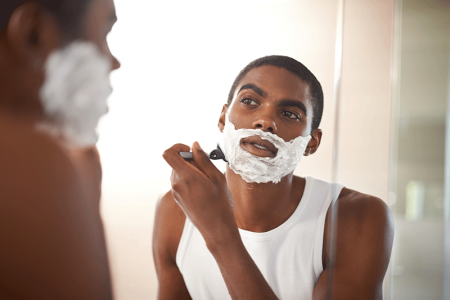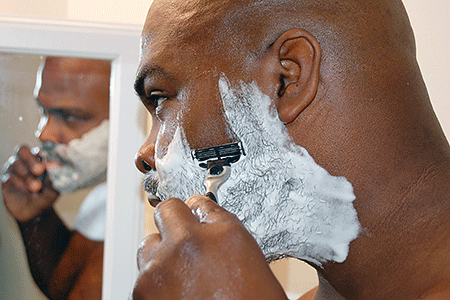Razor bump remedies for men with darker skin tones
Also known as shave bumps or barber’s bumps, razor bumps are common in people who shave. These bumps are especially common in men who have a darker skin tone. Some men live with constant discomfort and countless bumps in their beard area. Dermatologists say it doesn’t have to be that way.
Here’s what you can do at home to clear razor bumps, medically known as pseudofolliculitis barbae, or at least have fewer, less painful bumps.
Dermatologist tip #1: Grow your beard
If growing your beard is an option, you can get rid of razor bumps for good.
Here’s why growing a beard works. Razor bumps develop when the razor cuts hairs short. If you have coarse, curly hairs, these shortened hairs can curve into your skin. Your skin reacts to these ingrown hairs, and you see razor bumps.
When you stop shaving, the short hairs grow and spring out of your skin. Once the trapped hairs grow out, your skin will heal.
Before the bumps clear, you may develop new ones — even after you stop shaving. This happens when the hairs cut short by your last shave grow long enough to curve back into your skin. In time, these hairs will spring out.
You should see fewer razor bumps within one month. The bumps should be gone after three months.
Dermatologist tip #2: Change how you shave your face
If you need that clean-shaven look, you can reduce the number of bumps you get.
Never pull or stretch your skin while shaving and never pluck a hair inside a razor bump
Doing either can cause new razor bumps and worsen existing bumps.

To see fewer bumps, dermatologists say the first step is to figure out which direction the hairs in your beard area grow. This knowledge is key to preventing new razor bumps.
How to figure out which direction your beard hairs grow: If you’re tempted to skip over this step, don’t. You only need to do this once, and it’s easy to do.
Here’s how you figure it out:
Look in a mirror.
Pull tightly on the skin in your beard area and look closely.
Lift your head so that you can see how the hair grows under your chin.
Do you see one direction or different directions? Men who have coarse, curly hair usually see hairs growing in various directions.
If your facial hair grows in various directions, dermatologists recommend training your hair to grow in one direction. To do this, you’ll need a clean, unused, soft-bristle toothbrush.
Use the toothbrush to gently brush your hairs in one direction. Doing this daily will train your beard hair to grow in one direction, which can reduce new razor bumps significantly.
To see fewer razor bumps, shave daily — or at least every 2 to 3 days
When you shave less often, you give hairs time to grow long enough to curve into your skin.

Once you know how your hair grows, you’re ready to shave. Here’s what dermatologists recommend for men who have a darker skin tone and get razor bumps:
Wash your face with a gentle, non-comedogenic facial cleanser. Use a washcloth or soft-bristle face brush, applying the cleanser in a circular motion. This gentle massage-like motion helps to remove dead skin cells, which can reduce the number of hairs that curve back into your skin.
Rinse your face thoroughly with warm water to remove all cleanser.Hold a warm compress on your beard area for five minutes — or shave at the end of your shower. The warmth and moisture cause the hairs to swell, so they’re less likely to curve into your skin after shaving.
A warm compress also helps loosen the hairs that have curved into your skin and caused razor bumps. To make a warm compress, place a clean washcloth under warm water. Wring out the excess water. Then apply the washcloth to your beard area for five minutes.
If you prefer to shave at the end of your shower, dermatologists recommend using an anti-fog mirror. You can attach this mirror to the shower wall.Apply a moisturizing shaving cream, even when using an electric razor. Let the shaving cream sit on your skin for one or two minutes. Before you pick up your razor, make sure the shaving cream is wet. If it dries out before you shave, rinse your face. Then reapply, using more cream this time to prevent the cream from drying.
Tip
Never dry shave; always apply shaving cream.
Use a sharp razor. A single-blade razor or an electric razor is often recommended. Regardless of the razor you use, it must be sharp.
A single-blade razor will stay sharp for 5 to 7 shaves. After that number of shaves, it's time to replace the blade.
If you use an electric razor, replace the foils and blades as often as recommended in the instructions that came with the razor.Follow these dermatologist-recommended techniques as you shave:
- Shave slowly in the direction that your hairs grow. If your hairs grow in different directions, shave in the direction that you’re training the hairs to grow.
- Use short strokes, and never go over an area more than twice.
- When using a single-blade razor, rinse the blade after each swipe.
- Avoid shaving closely or putting much pressure on your skin.
To reduce the risk of razor bumps, change the blade on a single-blade razor after 5 to 7 shaves (or throw away a disposable razor)
A dull blade greatly increases the risk of razor bumps.

Rinse off the shaving cream with warm water. You want to rinse gently but thoroughly. Leaving any shaving cream on your skin can irritate it.
Place a cool compress on your skin. To make a cool compress, hold a clean washcloth underneath cool water. Once the washcloth is wet, place it on your just-shaved skin and leave it in place for five minutes.
Apply a soothing aftershave. Dermatologists recommend using an aftershave that’s specially formulated to reduce the risk of razor bumps and irritated skin. If an aftershave burns or stings, stop using it and try another one.
Dry your razor and store it in a dry place. This prevents bacteria from growing on your razor. Never leave your razor in the shower or on a wet sink.
Dermatologists developed this step-by-step process for men who have a darker skin tone and get razor bumps when they shave. It helps many men see fewer razor bumps. Some men, however, continue to get razor bumps.
When to see a dermatologist
If you continue to get razor bumps after you change your shaving technique, it’s time to see the medical skin expert. With a dermatologist’s customized treatment, you can get relief and avoid permanent changes to your skin. Men who continue to get razor bumps can develop permanent deep grooves and raised scars on their face.
To find a dermatologist in your area, go to Find a dermatologist.
Related AAD resources
Images
Getty Images
References
Daniel A, Gustafson CJ, et al. “Shave frequency and regimen variation effects on the management of pseudofolliculitis barbae.” J Drugs Dermatol. 2013;12(4):410-8.
Kelly AP, Serrano AMA. “Pseudofolliculitis barbae.” In: Taylor and Kelly’s Dermatology for Skin of Color. (second edition). McGraw Hill, USA, 2016:264-84.
Kundu RV, Patterson S. “Dermatologic conditions in skin of color: part II. Disorders occurring predominately in skin of color.” Am Fam Physician. 2013 Jun 15;87(12):859-65.
Ogunbiyi A. “Pseudofolliculitis barbae; current treatment options.” Clin Cosmet Investig Dermatol. 2019;12:241-7.
Written by:
Paula Ludmann, MS
Reviewed by:
Kesha Buster, MD, FAAD
Sandy Marchese Johnson, MD, FAAD
Bassel Hamdy Mahmoud, MD, PhD, FAAD
Last updated: 2/7/22
 Atopic dermatitis: More FDA-approved treatments
Atopic dermatitis: More FDA-approved treatments
 Biosimilars: 14 FAQs
Biosimilars: 14 FAQs
 How to trim your nails
How to trim your nails
 Relieve uncontrollably itchy skin
Relieve uncontrollably itchy skin
 Fade dark spots
Fade dark spots
 Untreatable razor bumps or acne?
Untreatable razor bumps or acne?
 Tattoo removal
Tattoo removal
 Scar treatment
Scar treatment
 Free materials to help raise skin cancer awareness
Free materials to help raise skin cancer awareness
 Dermatologist-approved lesson plans, activities you can use
Dermatologist-approved lesson plans, activities you can use
 Find a Dermatologist
Find a Dermatologist
 What is a dermatologist?
What is a dermatologist?
